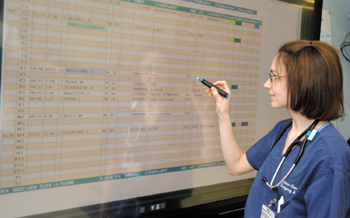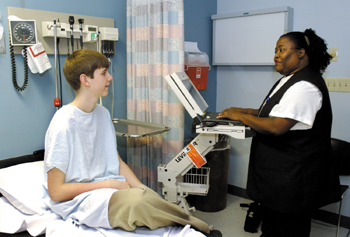
Dr. Stephanie Horn, a resident in the Emergency Department, uses the new eWhiteboard, a touch-sensitive plasma screen used for patient tracking. (photo by Dana Johnson)
Overcrowded VUMC emergency department turns to technology

Scott Kerr, a patient in the Emergency Department, is registered at the bedside by Terri Griffin, ER registration clerk. (photo by Dana Johnson)
Biomedical informatics pioneers at Vanderbilt University Medical Center have turned to technology to ease ER overcrowding and manage flow so patients receive faster, more efficient and safer care.
The new system centers around a 60-inch touch-sensitive plasma screen, which acts as the control center. The whiteboard is also displayed on flat screen computer monitors throughout the Emergency Department, including triage, the new fast track area, and the ER radiology reading room. From these monitors, physicians and nurses have rapid access to the patients’ entire medical record.
Developed by Dr. Dominik Aronsky, assistant professor of Biomedical Informatics, Dr. Ian Jones, assistant professor of Emergency Medicine, and programmer Kevin Lanaghan, health systems software engineer in the Informatics Center, the software is Web based and is integrated with StarPanel, Vanderbilt’s patient information and management system.
The eWhiteboard (eWB) is the only one of its kind in Tennessee and, according to preliminary feedback, unique throughout the United States because of its full integration with the hospital’s computerized patient record system, allowing ER physicians instant access to a patient’s lab, radiological and other test results. The system, developed over the past year, has completely replaced the manual dry-erase whiteboard, which is the traditional way of tracking patients in ERs.
Emergency rooms across the country are battling an emergency of a different type — overcrowding and long waits — resulting in a crisis that often forces ERs to divert ambulances to other locations.
With more than 50,000 adult patients and 30,000 children seeking emergency treatment at Vanderbilt each year, hospital leaders sought to develop a one-of-its-kind computerized patient information system, speeding patient registration and clinical care.
“Their work has been heroic,” said Dr. Corey Slovis, professor and chairman of the department of Emergency Medicine. “They have heard nearly 1,000 complaints and suggestions and have used every single idea possible to make our system highly user friendly and reliable.”
Slovis said that input, along with a successful attitude, has fueled the yearlong process and could serve as a model for change management.
“They have a ‘can-do’ kind of attitude,” Slovis explained. “And with Dr. Jones and Dr. Aronsky knowing the importance of the doctors’ and nurses’ needs at the forefront of any informatics system, we have been able to quickly respond to potential problems.”
With eWB, a patient can now be registered and in the computer system in less than three minutes. As soon as a patient is registered his or her name pops up on the screen, located across from the physician’s workstation, alerting staff that a patient is waiting to be seen, as well as the potential problem. The same information also appears in the form of a “screen saver” on computer monitors throughout the ER, providing staff with an operational view of the ER.
Should a patient arrive by ambulance, an ER treatment room can be reserved as soon as paramedics make their radio report.
Through the touch-activated screen, treatment staff are able to log in showing they are part of the care team for a particular patient. Color codes indicate room status, alert staff about the presence of patients with similar names, as well as an indication on the status of tests that have been ordered. Drop-down lists make selections quick, simple and easy to read.
The new system also acts as a quality management and educational tool, measuring patient wait and treatment times, as well as the different types of cases that a particular physician may see over a period of time. A surveillance system to track and report any type of unusual health outbreak, such as a possible biological terrorism act, is under development.
“The eWB system is a great management tool,” Aronsky explained. “If you can’t measure something, you can’t improve it. This will greatly benefit our clinical, educational and research efforts.”
Jones said the rapid patient registration was a key process to the system’s success.
“We were able to take a 10-page registration process and narrow that down to four key elements,” he explained. “If the patient arrives by ambulance, we have a wireless system that allows us to get this information at bedside.”
Aronsky has served as project manager over the development of the system. He said the biggest obstacle in implementing the eWB was change management.
“By replacing the manual whiteboard with an electronic version, we changed what has become the traditional way of doing things,” he said. “It was important to have leadership and staff buy into the change process.”
Careful consideration was given in meeting patient privacy standards, including those set by the Health Insurance Portability and Accountability Act. The screen saver view provides the ER staff with operational functionality; however access to patient information requires a two-level user authentication.
Highlights of the new system include:
• Rapid registration, allowing patients to interact with clinical staff within a short time period after arriving at the ER.
• Monitoring the number, acuity and problems of patients in the waiting room.
• Tracking of a number of components, including wait times, and the different types of cases a physician may treat.
• A standard list of chief complaints tied to the ICD 9 coding system, making reporting and billing more efficient.
• Integration with Vanderbilt’s longitudinal computerized patient record.
Future components of the system include:
• Integration with Vanderbilt’s new electronic bed request board, facilitating rapid hospital admissions by electronic ordering and bed availability notification.
• Submitting facility fees in real time, and immediate fee calculation for billing purposes.
• Computerization of discharge and documentation processes.
• Implementation of Vanderbilt’s physician order entry system.
“We’re very proud of what the ED team has been able to accomplish in developing this system,” Jones said. “And we are excited about what the future may hold as we continue to develop it and make refinements.”













